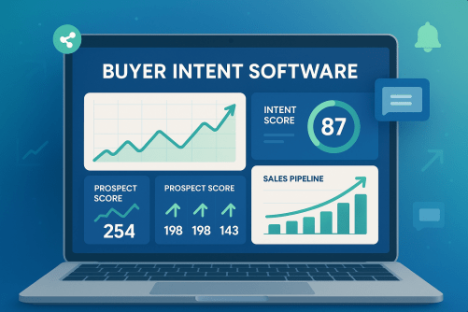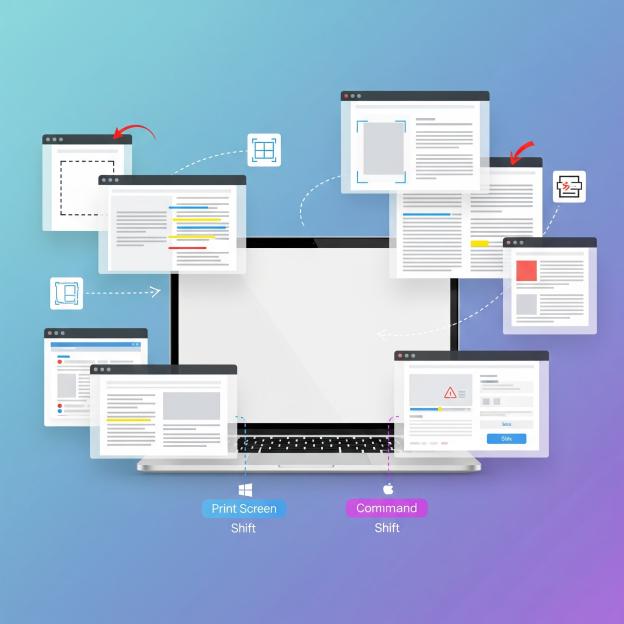Why Your Sales Team Needs Buyer Intent Software Right Now
Okay, let’s be real â if you’re still guessing which prospects are actually ready to buy, you’re basically playing sales roulette with your revenue. In today’s hyper-competitive market, waiting for leads to raise their hands is like waiting for your favorite influencer to reply to your DM â it’s probably not happening.
Buyer intent software is the game-changer that shows you exactly which companies are actively researching solutions like yours, what specific topics they’re exploring, and when they’re most likely to make a purchase decision. Think of it as having insider knowledge about your prospects’ shopping behavior without being creepy about it.
This comprehensive guide breaks down everything you need to know about buyer intent software, from how it works to the best tools available in 2025. Whether you’re a sales rep trying to hit quota or a marketing manager looking to generate better leads, this article will help you choose the right buyer intent solution for your business.
What is Buyer Intent Software and How Does It Work?
Buyer intent software is a sales intelligence tool that analyzes digital behavior patterns to identify when prospects are actively researching solutions in your market. These platforms track millions of data points across the internet to determine which companies are showing purchase intent signals.
The Technology Behind Buyer Intent Data
Modern buyer intent platforms use several data collection methods:
First-Party Intent Data: Information collected directly from your website, including page views, content downloads, demo requests, and engagement metrics. This data provides the most accurate picture of prospect behavior on your owned properties.
Third-Party Intent Data: Behavioral signals gathered from external websites, content syndication networks, review sites, and industry publications. This data reveals when prospects are researching solutions outside your website.
Predictive Analytics: Machine learning algorithms that analyze historical purchase patterns to predict which prospects are most likely to buy based on their current behavior.
Technographic Data: Information about the technology stack companies currently use, helping identify opportunities for upgrades or complementary solutions.
Key Intent Signals to Monitor
Effective buyer intent software tracks various behavioral indicators:
- Content consumption patterns â Which topics prospects research most frequently
- Search behavior â Keywords and phrases prospects use when researching solutions
- Competitor research â When prospects investigate alternative solutions
- Technology evaluations â Research into implementation requirements and integrations
- Budget planning activities â Signals indicating financial preparation for purchases
- Stakeholder involvement â Multiple people from the same company researching similar topics
Why Buyer Intent Software is Essential for Modern Sales Teams
Shorter Sales Cycles
Traditional cold outreach often requires months of nurturing before prospects show genuine interest. Buyer intent software helps you identify prospects who are already in research mode, allowing you to engage them at the perfect moment when they’re actively seeking solutions.
Higher Conversion Rates
By focusing on prospects who are demonstrating purchase intent, sales teams can achieve conversion rates that are 2-3 times higher than traditional lead generation methods. This targeted approach ensures you’re spending time on prospects who are actually ready to buy.
Improved Sales Productivity
Instead of making hundreds of cold calls to unqualified prospects, sales representatives can prioritize their outreach based on intent scores. This data-driven approach helps reps focus their efforts on the most promising opportunities.
Better Sales and Marketing Alignment
Buyer intent data provides a common framework for sales and marketing teams to evaluate lead quality. Marketing can use intent signals to create more targeted campaigns, while sales can prioritize follow-up based on real behavioral data.
Competitive Advantage
Most companies still rely on outdated lead scoring methods based on demographic data and form fills. By leveraging buyer intent software, you can identify opportunities before your competitors even know they exist.
Top 15 Buyer Intent Software Tools for 2025
1. Bombora (Best Overall Intent Data Platform)
Bombora is widely considered the gold standard for buyer intent data, providing comprehensive B2B intent signals across millions of business topics.
Key Features:
- Company Surge® data identifying organizations researching specific topics
- Topic taxonomy covering over 7,000 business subjects
- Intent data integration with major CRM and marketing automation platforms
- Weekly data refreshes ensuring current information
- Custom topic creation for niche industries
Pricing: Custom pricing based on data volume and integrations Best For: Enterprise companies needing comprehensive intent data coverage Pros: Extensive data coverage, reliable accuracy, strong integrations Cons: Higher cost, complex implementation for smaller teams
2. ZoomInfo (Best All-in-One Sales Intelligence)
ZoomInfo combines buyer intent data with contact information and company intelligence in a single platform.
Key Features:
- Intent data powered by Bombora partnership
- Comprehensive contact database with 150+ million business profiles
- Sales engagement tools including email sequences and call tracking
- Real-time alerts for intent signal changes
- Advanced search and filtering capabilities
Pricing: Plans start at $14,995/year for teams Best For: Sales teams needing intent data plus contact information Pros: Complete sales intelligence solution, user-friendly interface Cons: Expensive for small teams, data accuracy varies by region
3. 6sense (Best for Account-Based Marketing)
6sense specializes in account-based marketing and sales with advanced AI-powered buyer intent identification.
Key Features:
- AI-driven intent scoring across anonymous website visitors
- Account-based advertising and orchestration
- Predictive analytics for revenue forecasting
- Multi-channel engagement orchestration
- Advanced attribution and ROI measurement
Pricing: Custom pricing starting around $50,000/year Best For: Enterprise ABM programs with complex sales cycles Pros: Sophisticated AI capabilities, comprehensive ABM features Cons: Very expensive, complex setup, better suited for large enterprises
4. TechTarget (Best for Technology Companies)
TechTarget provides intent data specifically focused on technology buyers and IT decision-makers.
Key Features:
- Priority Engine® delivering technology purchase intent
- IT-focused content network providing high-quality intent signals
- Integration with major marketing automation platforms
- Detailed topic taxonomy for technology categories
- Account-level and contact-level intent scoring
Pricing: Custom pricing based on volume and features Best For: Technology companies selling to IT departments Pros: High-quality tech-focused data, strong accuracy for IT buyers Cons: Limited to technology sector, expensive for smaller companies
5. LeadSift (Best for Social Media Intent)
LeadSift specializes in social media buyer intent signals, monitoring conversations across social platforms.
Key Features:
- Social media monitoring for purchase intent signals
- Real-time conversation analysis and sentiment tracking
- Integration with CRM and marketing automation tools
- Custom keyword and topic monitoring
- Automated lead scoring based on social signals
Pricing: Plans start at $99/month for small teams Best For: Companies where prospects discuss solutions on social media Pros: Affordable pricing, unique social media focus, real-time monitoring Cons: Limited data sources compared to comprehensive platforms
6. Aberdeen (Best for Intent Data Accuracy)
Aberdeen focuses on providing highly accurate intent data through rigorous data validation processes.
Key Features:
- Intent data with industry-leading accuracy rates
- Custom intent topics for specific industries
- Real-time intent signal monitoring
- Integration with popular sales and marketing tools
- Detailed reporting and analytics dashboards
Pricing: Custom pricing based on data volume Best For: Companies prioritizing data accuracy over volume Pros: High data accuracy, reliable intent signals, good customer support Cons: Smaller data volume, higher cost per lead
7. G2 Buyer Intent (Best for Software Companies)
G2 leverages its software review platform to provide intent data for technology purchases.
Key Features:
- Intent data from software research and review activities
- Category-specific intent signals for software purchases
- Competitor comparison intent data
- Integration with existing G2 profiles and reviews
- Monthly intent signal reporting
Pricing: Custom pricing based on categories and volume Best For: Software companies listed on G2 platform Pros: High-quality software purchase intent, competitive intelligence Cons: Limited to software categories, requires G2 presence
8. Demandbase (Best for Enterprise ABM)
Demandbase offers comprehensive account-based marketing and sales intelligence with strong intent capabilities.
Key Features:
- Account intelligence and buyer intent data
- Personalization and web experiences
- Advertising and engagement orchestration
- Sales intelligence and conversation analytics
- Revenue attribution and analytics
Pricing: Custom enterprise pricing Best For: Large enterprises with complex ABM requirements Pros: Comprehensive ABM platform, strong analytics, good integrations Cons: Very expensive, complex implementation, enterprise-focused
9. Foundry (Formerly IDG)
Foundry provides buyer intent data focused on technology decision-makers through its extensive content network.
Key Features:
- Technology buyer intent from premium content consumption
- Account-level and contact-level intent scoring
- Integration with marketing automation platforms
- Custom intent topics for specific technology categories
- Detailed intent signal reporting and analytics
Pricing: Custom pricing based on volume and integrations Best For: Technology companies targeting enterprise IT buyers Pros: High-quality technology intent data, strong enterprise focus Cons: Limited to technology sector, premium pricing
10. Kickfire (Best for Website Visitor Identification)
Kickfire specializes in identifying anonymous website visitors and their buyer intent signals.
Key Features:
- Anonymous visitor identification and intent tracking
- Real-time website visitor alerts
- Integration with CRM and marketing automation
- Lead scoring based on website behavior
- Account-based website personalization
Pricing: Plans start at $300/month Best For: Companies wanting to identify anonymous website visitors Pros: Real-time visitor identification, affordable pricing, easy implementation Cons: Limited data sources, focus primarily on website behavior
11. Lead411 (Best for Small Business Intent Data)
Lead411 provides buyer intent data and contact information specifically designed for small and medium businesses.
Key Features:
- Buyer intent data with contact information
- Real-time alerts for intent signal changes
- Email verification and contact enrichment
- CRM integration and data synchronization
- Trigger-based prospecting and outreach
Pricing: Plans start at $99/month Best For: Small to medium businesses needing affordable intent data Pros: Affordable pricing, SMB-friendly features, good customer support Cons: Limited data volume, less sophisticated analytics
12. Cyance (Best for Predictive Intent Analytics)
Cyance focuses on predictive analytics to identify buyer intent patterns and forecast purchase timing.
Key Features:
- Predictive buyer intent modeling
- Time-to-purchase forecasting
- Account scoring and prioritization
- Integration with sales and marketing tools
- Custom predictive models for specific industries
Pricing: Custom pricing based on model complexity Best For: Companies needing predictive purchase timing insights Pros: Advanced predictive capabilities, custom modeling, accurate forecasting Cons: Complex setup, requires data science expertise, higher cost
13. EverString (Now Part of 6sense)
Although now integrated into 6sense, EverString’s AI-powered approach to buyer intent identification remains influential.
Key Features:
- AI-driven buyer intent identification
- Predictive account scoring and ranking
- Custom intent models for specific use cases
- Integration with existing sales and marketing stacks
- Advanced analytics and reporting capabilities
Note: Now available through 6sense platform Best For: Companies needing AI-powered intent identification Pros: Sophisticated AI capabilities, accurate predictions, custom modeling Cons: No longer available as standalone product
14. Lattice Engines (Now Part of Dun & Bradstreet)
Lattice Engines pioneered many predictive analytics approaches now common in buyer intent software.
Key Features:
- Predictive buyer intent and lead scoring
- Account-based marketing and sales intelligence
- Custom predictive models and algorithms
- Integration with major CRM and marketing platforms
- Advanced analytics and performance measurement
Note: Now available through Dun & Bradstreet solutions Best For: Enterprise companies needing sophisticated predictive analytics Pros: Advanced predictive capabilities, enterprise-grade features Cons: Complex implementation, requires technical expertise
15. MadKudu (Best for Product-Led Growth)
MadKudu specializes in buyer intent identification for product-led growth companies and freemium business models.
Key Features:
- Product usage and engagement intent scoring
- Predictive lead scoring for PLG companies
- Integration with product analytics and CRM tools
- Custom scoring models for freemium conversions
- Real-time intent signal monitoring
Pricing: Custom pricing based on usage volume Best For: SaaS companies with product-led growth models Pros: PLG-specific features, product usage insights, accurate freemium conversion prediction Cons: Limited to PLG companies, requires product usage data
How to Choose the Right Buyer Intent Software
Assess Your Data Requirements
Data Volume Needs: Consider how many accounts you need to monitor and how frequently you need data updates. Enterprise companies may require millions of accounts, while smaller businesses might only need thousands.
Data Sources: Evaluate whether you need comprehensive web-wide intent data or if specific sources (social media, review sites, industry publications) are more important for your market.
Geographic Coverage: Ensure the platform provides adequate coverage for your target markets, especially if you sell internationally.
Industry Specificity: Some platforms excel in specific industries (technology, healthcare, manufacturing) while others provide broader coverage.
Evaluate Integration Capabilities
CRM Integration: Ensure seamless integration with your existing CRM system (Salesforce, HubSpot, Pipedrive) to automatically update prospect records with intent data.
Marketing Automation: Look for native integrations with your marketing automation platform to trigger campaigns based on intent signals.
Sales Engagement Tools: Consider how intent data will integrate with your sales engagement and outreach tools.
Analytics Platforms: Evaluate integration capabilities with your existing business intelligence and analytics tools.
Consider Implementation and Training Requirements
Technical Complexity: Assess whether your team has the technical expertise to implement and maintain the platform, or if you’ll need external support.
User Training: Understand the learning curve for your sales and marketing teams to effectively use the platform.
Data Governance: Consider how the platform handles data privacy, compliance, and security requirements.
Ongoing Support: Evaluate the vendor’s customer success and technical support offerings.
Calculate Return on Investment
Cost Per Lead: Compare the cost of intent-driven leads versus traditional lead generation methods.
Conversion Rate Improvement: Estimate the potential improvement in conversion rates from better lead targeting.
Sales Cycle Reduction: Calculate the value of shorter sales cycles enabled by intent data.
Sales Productivity Gains: Measure the impact of better lead prioritization on sales team productivity.
Implementation Best Practices for Buyer Intent Software
Start with Clear Objectives
Before implementing buyer intent software, establish clear goals and success metrics:
Revenue Goals: Define how much additional revenue you expect to generate from intent data.
Conversion Targets: Set specific targets for lead-to-opportunity and opportunity-to-close conversion rate improvements.
Activity Metrics: Establish benchmarks for sales activity efficiency and prospect engagement rates.
Timeline Expectations: Set realistic timelines for implementation, training, and results achievement.
Develop Intent Signal Taxonomy
Create a comprehensive framework for categorizing and prioritizing intent signals:
Topic Hierarchy: Organize intent topics from broad industry categories to specific product features.
Signal Strength: Define scoring criteria for different types of intent signals (high, medium, low priority).
Timing Indicators: Establish guidelines for interpreting when prospects are likely to make purchase decisions.
Competitive Signals: Identify intent patterns that indicate prospects are evaluating competitors.
Create Integrated Workflows
Develop workflows that connect intent data with your existing sales and marketing processes:
Lead Qualification: Integrate intent scores with your existing lead scoring methodology.
Sales Handoff: Create clear criteria for when marketing-qualified leads become sales-qualified based on intent signals.
Outreach Personalization: Develop templates and messaging frameworks based on specific intent topics.
Follow-up Cadences: Create different engagement sequences based on intent signal strength and timing.
Train Your Team Effectively
Invest in comprehensive training to ensure your team can effectively leverage intent data:
Platform Training: Ensure all users understand how to navigate and interpret the software interface.
Data Interpretation: Train team members to correctly interpret intent signals and scoring.
Sales Messaging: Develop training on how to incorporate intent insights into sales conversations.
Campaign Development: Train marketing teams to create targeted campaigns based on intent data.
Measuring Success with Buyer Intent Software
Key Performance Indicators
Lead Quality Metrics:
- Lead-to-opportunity conversion rate
- Opportunity-to-close conversion rate
- Average deal size for intent-driven leads
- Sales cycle length reduction
Sales Activity Metrics:
- Email response rates for intent-based outreach
- Meeting acceptance rates from intent-driven prospects
- Call connection rates for intent-qualified leads
- Pipeline velocity improvement
Revenue Impact Metrics:
- Revenue attribution to intent data
- Cost per acquisition reduction
- Customer lifetime value for intent-driven customers
- Overall revenue growth
Operational Efficiency Metrics:
- Time to first contact for intent signals
- Sales representative productivity increase
- Marketing campaign performance improvement
- Lead scoring accuracy enhancement
Regular Performance Reviews
Conduct monthly and quarterly reviews to optimize your buyer intent software implementation:
Data Quality Assessment: Review the accuracy and relevance of intent signals to ensure data quality remains high.
Score Calibration: Adjust intent scoring thresholds based on actual conversion performance.
Process Optimization: Refine workflows and processes based on user feedback and performance data.
Training Updates: Provide ongoing training to address knowledge gaps and new platform features.
Future Trends in Buyer Intent Software
Artificial Intelligence Advancement
Predictive Accuracy: AI algorithms will become increasingly sophisticated at predicting purchase timing and likelihood.
Signal Integration: Machine learning will better combine multiple data sources to create more comprehensive intent profiles.
Automated Insights: AI will automatically identify patterns and opportunities that human analysts might miss.
Natural Language Processing: Better understanding of unstructured data sources like social media conversations and review comments.
Privacy and Compliance Evolution
First-Party Data Focus: Increasing emphasis on first-party intent data collection due to privacy regulations.
Consent Management: More sophisticated tools for managing consent and data usage permissions.
Transparency Requirements: Greater transparency about data sources and collection methods.
Cross-Border Compliance: Better handling of international data privacy regulations and requirements.
Integration Ecosystem Expansion
Revenue Operations: Deeper integration with revenue operations platforms and methodologies.
Customer Success: Extension of intent monitoring to existing customer expansion and retention use cases.
Partner Ecosystems: Integration with partner and channel data to identify collaborative opportunities.
Industry-Specific Solutions: More specialized intent data solutions for specific industries and use cases.
Common Challenges and Solutions
Data Quality Issues
Challenge: Inconsistent or inaccurate intent signals leading to poor lead quality.
Solutions:
- Implement data validation processes to verify intent signal accuracy
- Use multiple data sources to confirm intent patterns
- Regularly review and adjust intent scoring criteria
- Establish feedback loops between sales teams and data providers
Sales Team Adoption
Challenge: Sales representatives not effectively using intent data in their prospecting efforts.
Solutions:
- Provide comprehensive training on intent data interpretation
- Create simple workflows that integrate intent data into existing processes
- Demonstrate clear ROI and success stories from intent-driven activities
- Implement gamification and incentives for intent data usage
Information Overload
Challenge: Too many intent signals creating noise and reducing effectiveness.
Solutions:
- Implement intelligent filtering and prioritization systems
- Create clear scoring hierarchies for different types of intent signals
- Develop automated workflows to handle routine intent-driven activities
- Focus on the highest-value intent signals for manual review
Integration Complexity
Challenge: Difficulty integrating intent data with existing sales and marketing technology stacks.
Solutions:
- Work with vendors that offer native integrations with your existing tools
- Invest in proper technical implementation support
- Create standardized data formats and workflows
- Consider middleware solutions for complex integration requirements
Conclusion: Maximizing Your Investment in Buyer Intent Software
Buyer intent software represents one of the most significant advances in sales and marketing technology in recent years. By providing unprecedented visibility into prospect behavior and purchase timing, these platforms enable sales teams to work more efficiently and achieve better results.
The key to success lies in choosing the right platform for your specific needs, implementing it properly with clear processes and training, and continuously optimizing based on performance data. Companies that effectively leverage buyer intent software typically see 20-30% improvements in conversion rates and significant reductions in sales cycle length.
As privacy regulations continue to evolve and buyer behavior becomes increasingly digital, the importance of sophisticated intent data will only grow. Organizations that invest in buyer intent software now will have a significant competitive advantage as these trends accelerate.
Remember that buyer intent software is not a magic solution that automatically generates revenue. It’s a powerful tool that, when properly implemented and utilized, can dramatically improve the efficiency and effectiveness of your sales and marketing efforts. Focus on clear objectives, proper training, and continuous optimization to maximize your return on investment.
The future of B2B sales is data-driven, and buyer intent software is leading that transformation. Whether you’re a startup looking to compete with larger companies or an enterprise seeking to improve sales efficiency, the right buyer intent platform can provide the insights you need to grow your business more effectively.
Take the time to evaluate your options carefully, implement thoroughly, and measure results consistently. With the right approach, buyer intent software can become one of your most valuable sales and marketing investments, driving sustainable growth and competitive advantage for years to come.







